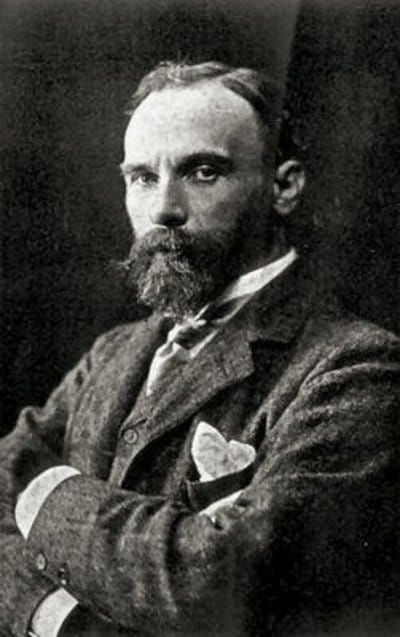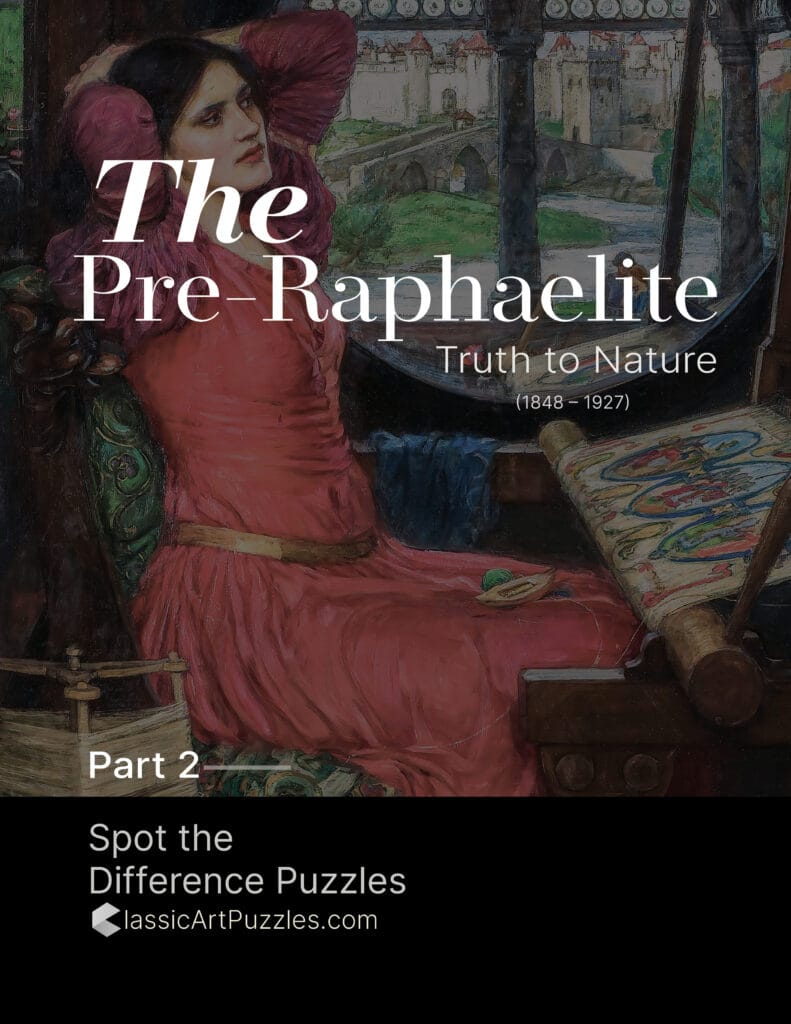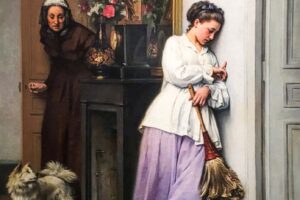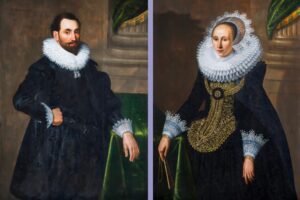Table of Contents
Overview
Consulting the Oracle (1884) by John William Waterhouse depicts a scene steeped in mystery, ritual, and human longing. A young prophetess, draped in dark robes, gestures toward her listeners as smoke rises from the brazier at her side. Before her, a group of women sit cross-legged on patterned carpets, their faces a mixture of awe, fear, and expectation.
Waterhouse (1849–1917), though painting after the original Pre-Raphaelite Brotherhood, was deeply inspired by their attention to color, storytelling, and symbolism. In this work, he blends Orientalist setting with classical subject matter, creating a vision of ancient ritual that resonated with Victorian fascination for myth, mysticism, and prophecy.
Exhibited in 1884, Consulting the Oracle captured Victorian audiences with its theatrical staging and emotional tension. Today, it remains one of Waterhouse’s defining early works, a painting where drama, beauty, and mystery converge.
The Artist
John William Waterhouse (1849–1917) was a British painter often associated with the later Pre-Raphaelite movement. Best known for his depictions of women in myth and literature, he combined classical themes with romantic naturalism. His hallmark style blended jewel-like color, dramatic narrative, and psychological depth, making him one of the most enduring Victorian painters. Works like The Lady of Shalott and Hylas and the Nymphs define his legacy as a bridge between Pre-Raphaelitism and Symbolism.

The Story Behind the Painting
The Power of Prophecy
The subject reflects the ancient practice of consulting oracles — women believed to channel divine voices, offering visions of the future. For Victorians, such imagery carried both exotic allure and symbolic depth, embodying humanity’s eternal desire to glimpse fate.
A Victorian Fascination
In the 19th century, mysticism, spiritualism, and Orientalism captivated public imagination. Waterhouse combined these themes in Consulting the Oracle, evoking an ancient Middle Eastern or Mediterranean interior filled with ritual and expectation.
Waterhouse’s Artistic Journey
This painting came early in Waterhouse’s career, before his more famous mythological subjects of the 1890s. Yet it already demonstrates his fascination with female figures as central to narrative drama and symbolic meaning.
Composition and Subjects
The Oracle
At the left, the oracle stands in shadow, her hand outstretched, eyes intent. She is both commanding and enigmatic, her presence the focal point of the gathering.
The Listening Women
Seven women sit in varied poses on patterned rugs, each responding differently to the oracle’s words. One clasps her chest in fear, another hides her face, others lean forward in rapt attention. Together, they embody the spectrum of human responses to prophecy — hope, dread, curiosity, disbelief.
The Interior Setting
The rich wooden architecture, arched windows, and colored glass create a decorative backdrop. Oil lamps and vessels add atmosphere, while patterned textiles anchor the women in ritual space. The environment intensifies the sense of enclosed mystery.
Symbolic Details
The brazier’s smoke suggests divine presence, while the women’s contrasting expressions reflect prophecy’s dual edge — guidance and doom. The exoticism of the setting heightens its theatrical and symbolic power.
Art Style and Techniques
Pre-Raphaelite Influence
Waterhouse employs the Pre-Raphaelite commitment to vivid color and narrative clarity. Each figure is distinct, every fabric rendered with jewel-like intensity.
Orientalist Allure
The architectural details and costumes reflect Victorian Orientalist taste, popularized by fascination with the Middle East. While not historically precise, they heighten the sense of ancient ritual and mystery.
Psychological Drama
Unlike static historical scenes, Waterhouse captures emotional variety. The women’s faces and gestures form a chorus of human responses, making the painting as much about psychology as prophecy.
Legacy and Reflection
Reception in 1884
When first exhibited, the painting attracted attention for its theatricality and meticulous design. Critics noted Waterhouse’s gift for dramatic staging and his ability to blend historical imagination with emotional immediacy.
Lasting Significance
Today, Consulting the Oracle is recognized as a pivotal early work that foreshadowed Waterhouse’s later masterpieces. It shows his mastery of narrative composition, fascination with female-centered stories, and ability to unite Pre-Raphaelite color with Symbolist atmosphere.
Featured in Our Collection
Consulting the Oracle is included in our Pre-Raphaelite Spot-the-Difference Puzzle Flipbook Part 2. Its rich textiles, varied gestures, and layered symbolism make it a compelling puzzle subject. By seeking hidden differences, you sharpen observation and engage with Waterhouse’s world of prophecy and mystery in an interactive way.
The Whisper of Fate
The prophetess gestures, the women listen, the smoke drifts upward. In Consulting the Oracle, Waterhouse transforms an ancient ritual into timeless allegory — where fate is glimpsed, mystery endures, and human longing is laid bare.
More About Artist

John William Waterhouse RA (baptized April 6, 1849 – February 10, 1917) was a renowned English painter closely associated with the Pre-Raphaelite style and Victorian Romanticism. Born in Rome to English painter parents, Waterhouse moved to London in childhood, where he was exposed to a rich artistic environment near the Victoria and Albert Museum. He trained at the Royal Academy of Art, initially studying sculpture before switching to painting. Waterhouse became famous for his vibrant, detailed depictions of mythological, literary, and classical subjects, bringing the Pre-Raphaelite aesthetic into the early 20th century.
Artist Style and Movement
Waterhouse’s style bridges Academic art and Pre-Raphaelite influences, characterized by luminous colors, precise detail, and narrative richness. His subjects often derived from classical literature, myths, and poetry—especially works by Tennyson, Shakespeare, and Homer—delivered with romanticism and emotional intensity. He focused on female protagonists, enchantresses, and tragic heroines, exploring themes of love, fate, and destiny. Though rooted in Victorian ideals, his brushwork sometimes reflected Impressionist influences.
Artwork Profile
- After the Dance (1876): An early success capturing a courtly scene post-dance with refined detail and vibrant colors.
- A Sick Child Brought Into the Temple of Aesculapius (1877): A dramatic and poignant painting reflecting ancient themes of healing and faith.
- Diogenes (1882): A philosophical portrait of the Cynic philosopher Diogenes, embodying simplicity and defiance.
- The Favourites of the Emperor Honorius (1883): A richly detailed historical scene depicting imperial court life.
- Consulting the Oracle (1884): An evocative scene emphasizing Greek antiquity and mysticism.
- The North-West Passage (1874): A patriotic narrative painting recalling British exploration.
- Penelope and the Suitors (1912): Reflects Waterhouse’s fascination with Homeric epics, childbirth, and female virtues.
- “Am Half-Sick of Shadows,” Said the Lady of Shalott (1915): A late portrayal of Tennyson’s tragic heroine, encapsulating Waterhouse’s romantic and symbolic style.
John William Waterhouse’s enduring legacy lies in his masterful synthesis of Pre-Raphaelite romanticism and Victorian poetic storytelling. His paintings display an exquisite balance of detailed craftsmanship and emotional narrative, making him one of the last significant bearers of the Pre-Raphaelite tradition into the 20th century. His works continue to captivate with their rich color palettes, mythic themes, and profound human emotions.




